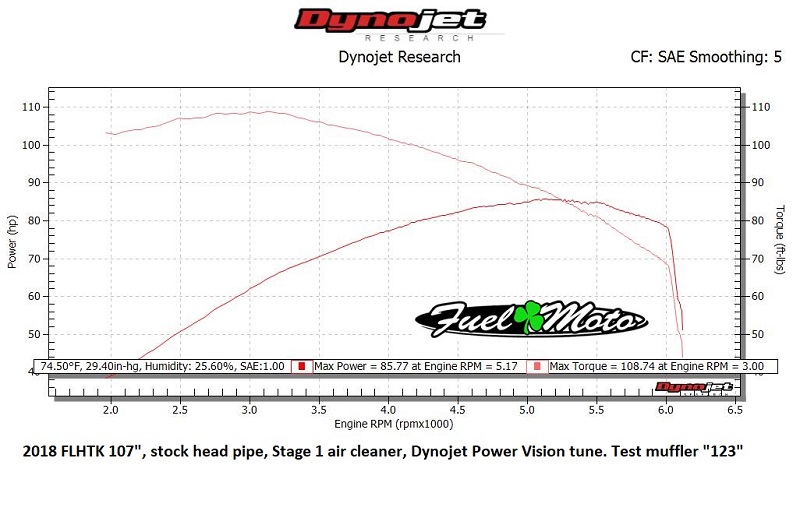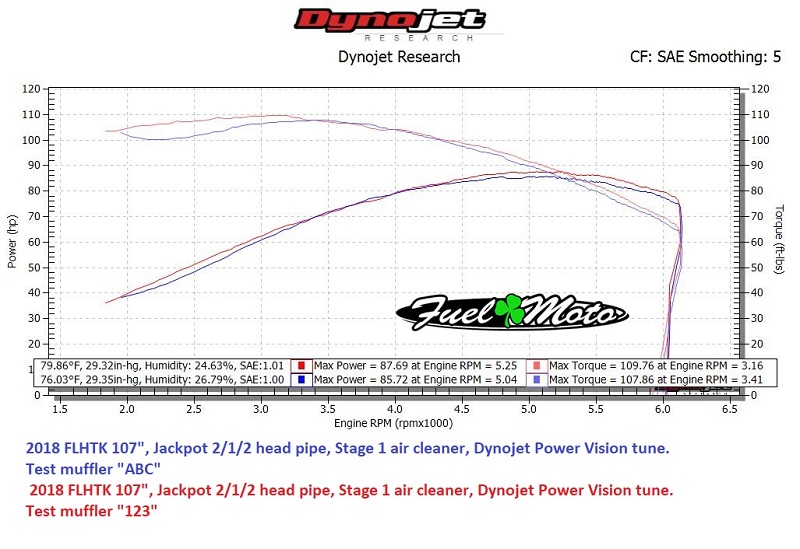We’ve been noting the importance of using properly baffled mufflers for many years. We have found that Milwaukee-8 engines are even more exhaust sensitive than Twin Cam engines. We wanted to compile some easy to understand data that may help choose the proper components for your application.
Muffler choice can make or break an entire combination. The current trend of large, open baffles is unfortunately the opposite of what these motors want with most configurations, especially when you go to an aftermarket cam. We’ve seen as much as 30+ Tq loss at lower RPMs using large mufflers. These excessively large baffles contribute to poor response and tunability. If you have mufflers with excessively large baffles, big tapered, or stepped cores, they are costing you considerable performance. Reversion is effectively reducing velocity that is essential to low-mid RPM performance and response. For information on exhaust theory and design, some of the best written resources are the tech articles from Burns Stainless.
To dive deeper into understanding how dyno charts are read and interpreted: How to Read a Dyno Chart.
Effects Between Mufflers Combinations
The following testing is going to document the specific differences in performance between a muffler with an overly large baffle (we’re calling it muffler “ABC”), versus a properly baffled muffler for this application (muffler “123” has a conventional core with removable secondary inserts in place). The test vehicle is a 2018 H-D FLHTK Ultra Limited. All testing was done on the same day in the Fuel Moto Dynojet test cell and each combination was fully tuned with Dynojet Power Vision. We tested the following combinations:
- Stock headpipe, Muffler “ABC”, Stage 1 air cleaner, Dynojet Power Vision tune
- Stock headpipe, Muffler “123”, Stage 1 air cleaner, Dynojet Power Vision tune
- Jackpot 2/1/2 headpipe, Muffler “ABC”, Stage 1 air cleaner, Dynojet Power Vision tune
- Jackpot 2/1/2 headpipe, Muffler “123”, Stage 1 air cleaner, Dynojet Power Vision tune
- Wood WM8-22x cam, Jackpot 2/1/2 headpipe, Muffler “ABC”, Stage 1 air cleaner, Dynojet Power Vision tune
- Wood WM8-22x cam, Jackpot 2/1/2 headpipe, Muffler “123”, Stage 1 air cleaner, Dynojet Power Vision tune
Test 1) Stock Head Pipe, Muffler “ABC”, Stage 1 Air Cleaner, Dynojet Power Vision Tune

Test 2) Stock Head Pipe, Muffler “123”, Stage 1 Air Cleaner, Dynojet Power Vision Tune

Note the difference below comparing the two mufflers with the stock head pipe. The larger baffled mufflers are making measurably less torque than the conventional baffled mufflers, but performance could be considered reasonable in this application.

Test 3) Jackpot 2/1/2 Head Pipe, Muffler “ABC”, Stage 1 Air Cleaner, Dynojet Power Vision Tune

Test 4) Jackpot 2/1/2 Head Pipe, Muffler “123”, Stage 1 Air Cleaner, Dynojet Power Vision Tune

Note the difference below between the two mufflers when you replace the head pipe with the non catalyst pipe. Numbers increase slightly but there is a more defined dip with the larger baffles. The merge collector in the 2/1/2 head pipe is helping the deficiencies. Throttle response is noticeably different between the two setups as well. The setup with the larger baffles is lacking in response.

Test 5) Wood WM8-22x Cam, Jackpot 2/1/2 Head Pipe, Muffler “ABC”, Stage 1 Air Cleaner, Dynojet Power Vision Tune

Test 6) Wood WM8-22x Cam, Jackpot 2/1/2 Head Pipe, Muffler “123”, Stage 1 Air Cleaner, Dynojet Power Vision Tune

They made the same torque! but wait a minute this is where the testing gets really interesting. When you add the aftermarket Wood WM8-22x cam to the mix it really separates the two mufflers. There is now a huge defined loss in low RPM power; the motor is simply not happy and does not respond with the large baffled mufflers in the lower RPM’s. You are looking at a difference as much as 20Tq in the lower RPM’s. Throttle response is also poor. Riding the bike seat of the pants difference is night and day; mufflers are the only difference.
The WM8-22x is one of the strongest low-mid RPM cams on the market. If you were using another cam that is not quite as strong on the bottom or a different pipe without a properly designed merge collector, the results of the larger baffles would be even worse. The mufflers we tested were not even the worst offenders we’ve seen (yes we’ve seen even worse). Also consider each of these combinations were properly dyno tuned and properly tested.

Below you will find an overlay of each of the runs from this test. Most interesting to note is the WM8-22x test with the large “ABC” mufflers, which made less power below 2600 RPM than with the stock cam, head pipe and the same mufflers!

CHAPTER 2: 10/8/2019 Performance & Dyno Effects Between Mufflers on V-Twin Engines
The image below is the same 124″ Milwaukee-8 engine fully tuned (a day apart). The only difference is the mufflers which were swapped. Nearly identical peak numbers, however the throttle response on one is crisp and responsive, the other is soggy and limp feeling. In this example the customer was certain his mufflers would work and was willing to compromise and then change mufflers if necessary, so we did the build and tuned it… twice. Now that we’re in fall and getting ready for winter engine builds we can’t stress the importance of exhaust choice enough, it will make or break the results of your combination. Set your build up for success!

